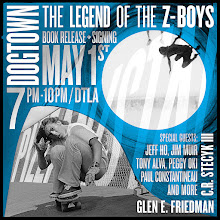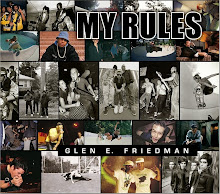
Tuesday, December 24, 2019
Tuesday, December 17, 2019
TOGETHER FOREVER book
Hard to find on line now, except at B&N
or better yet, go check it out in store!
some love from the boys social media....
Thursday, December 12, 2019
Monday, December 9, 2019
GEF - Q&A + BOOK SIGNING for
"DOGTOWN - The Legend of The Z-Boys"
This Wednesday
This Wednesday! 6-8pm
"DogTown - The Legend of the Z-Boys" Q&A and book signing
with Glen E. Friedman in Brooklyn at Pilgrim Surf Supply (Williamsburg).

Monday, December 2, 2019
"Talk Music Talk with boice"
glen E. friedman Podcast Interview
There’s no such thing as too much glen E. friedman. The legendary photographer released three books in 2019. Expanded reissues of two classics: Keep Your Eyes Open - the Fugazi photographs and DogTown: The Legend of the Z-Boys (with C.R. Stecyk III) about the West Los Angeles skateboard scene from 1975-1985. Both titles are available from Akashic Books. The third, Together Forever (Rizzoli Books), features photos of Beastie Boys and Run-DMC. glen also shot the iconic album covers of Public Enemy’s It Takes a Nation of Millions to Hold Us Back and Beastie Boys’ Check Your Head. glen’s reputation was built on documenting the cultures of hip-hop, punk and skateboarding but his photography is far from simple snapshots; it’s the work of an artist who possesses the craft to make you experience that singular moment his camera caught each and every time.==============================
boice is the host/producer of a brand new podcast. The StrandCast, The Official Podcast of Strand Bookstore in NYC at 12th and Broadway. Every other week listen to longform conversations with authors from different genres.SUBSCRIBE ON iTUNES: bit.ly/TalkMusicTalk
SUBSCRIBE ON GOOGLE PLAY: bit.ly/TMTgoogleplay
Wednesday, November 20, 2019
Public Talk with Guy Picciotto and myself
at the MIAMI BOOK FAIR
Saturday
At 12 noon I will be signing copies of my newest book TOGETHER FOREVER.
At 3:30 I will be joined by Guy Picciotto of Fugazi to talk about the re-released FUGAZI book "Keep Your Eyes Open"


for more event information click HERE.
Monday, November 18, 2019
TODAY in NEW YORK CITY 7pm
TOGETHER FOREVER book event!

I will be having a public talk and book signing at Barnes & Nobel on Union Square. Come get the new book and stay for the talk and get your book signed if you want. DMC and Chuck D. will be there for the talk and quite possibly some other contributors to the book may be in the house.
Get advance book/pass before it sells out here:
https://togetherforevernyc.eventbrite.com

"Extra Strength Posse 1987"
Friday, November 15, 2019
Chuck D. of Public Enemy
View this post on InstagramA post shared by glen E. friedman Ⓥ (@glenefriedman) on
Monday, November 11, 2019
GEF x OBEY x TOGETHER FOREVER
T-shirts and Hoodies Available Now
Very rare i allow my work on apparel, but i like the graphic renditions Shepard does with my photographs and I think they work much better on cloth than actual photos. Stoked they did this!
from OBEY:
In celebration of legendary photographer GEF's new book release Together Forever, Shepard Fairey and Glen E. Friedman have collaborated once again to create illustrations based on iconic photographs of RUN-DMC and Beastie Boys from the newly released book for OBEY Clothing. Together Forever symbolizes two groups working together. In a time of such divisiveness it’s a great reminder that there doesn’t need to be a racial divide. Exclusive pre-order available at the Obey clothing site, for the Together Forever collection.

click here for: TOGETHER FOREVER COLLECTION
Monday, November 4, 2019
Thursday, October 31, 2019
Book Signing in Los Angeles this Saturday Evening
Hope to see you all there.



Tuesday, October 1, 2019
Together Forever book signing in Rome Friday 5 October
Questo è un appuntamento per gli amanti della cultura punk, hip hop e dello skateboarding ribelle.
Venerdì 4 ottobre alle 19 Glen E. Friedman sarà a Officine Fotografiche Roma per un talk e la presentazione del libro Together Forever.
Non potete perdervelo!

We will be screening the 20 year old FUCK YOU ALL mini doc made by Roma's own Fluid Video crew.
And I will be signing books and answering questions.
Friday, September 27, 2019
Together Forever Book Signing Event on Oct. 1st!
https://www.facebook.com/events/387743558611536/

Thursday, September 26, 2019
TOGETHER FOREVER book comes out Tuesday!
View this post on InstagramA post shared by glen E. friedman Ⓥ (@glenefriedman) on
Thursday, September 12, 2019
The "3.5% rule":
How A Small Minority Can Change The World
Nonviolent protests are twice as likely to succeed as armed conflicts – and those engaging a threshold of 3.5% of the population have never failed to bring about change
In 1986, millions of Filipinos took to the streets of Manila in peaceful protest and prayer in the People Power movement. The Marcos regime folded on the fourth day.
In 2003, the people of Georgia ousted Eduard Shevardnadze through the bloodless Rose Revolution, in which protestors stormed the parliament building holding the flowers in their hands.
Earlier this year, the presidents of Sudan and Algeria both announced they would step aside after decades in office, thanks to peaceful campaigns of resistance.
In each case, civil resistance by ordinary members of the public trumped the political elite to achieve radical change.
There are, of course, many ethical reasons to use nonviolent strategies. But compelling research by Erica Chenoweth, a political scientist at Harvard University, confirms that civil disobedience is not only the moral choice; it is also the most powerful way of shaping world politics – by a long way.
Looking at hundreds of campaigns over the last century, Chenoweth found that nonviolent campaigns are twice as likely to achieve their goals as violent campaigns. And although the exact dynamics will depend on many factors, she has shown it takes around 3.5% of the population actively participating in the protests to ensure serious political change.
Chenoweth’s influence can be seen in the recent Extinction Rebellion protests, whose founders say they have been directly inspired by her findings. So just how did she come to these conclusions?
Needless to say, Chenoweth’s research builds on the philosophies of many influential figures throughout history. The African-American abolitionist Sojourner Truth, the suffrage campaigner Susan B Anthony, the Indian independence activist Mahatma Gandhi and the US civil rights campaigner Martin Luther King have all convincingly argued for the power of peaceful protest.
Yet Chenoweth admits that when she first began her research in the mid-2000s, she was initially rather cynical of the idea that nonviolent actions could be more powerful than armed conflict in most situations. As a PhD student at the University of Colorado, she had spent years studying the factors contributing to the rise of terrorism when she was asked to attend an academic workshop organised by the International Center of Nonviolent Conflict (ICNC), a non-profit organisation based in Washington DC. The workshop presented many compelling examples of peaceful protests bringing about lasting political change – including, for instance, the People Power protests in the Philippines.
But Chenoweth was surprised to find that no-one had comprehensively compared the success rates of nonviolent versus violent protests; perhaps the case studies were simply chosen through some kind of confirmation bias. “I was really motivated by some scepticism that nonviolent resistance could be an effective method for achieving major transformations in society,” she says.
Working with Maria Stephan, a researcher at the ICNC, Chenoweth performed an extensive review of the literature on civil resistance and social movements from 1900 to 2006 – a data set then corroborated with other experts in the field. They primarily considered attempts to bring about regime change. A movement was considered a success if it fully achieved its goals both within a year of its peak engagement and as a direct result of its activities. A regime change resulting from foreign military intervention would not be considered a success, for instance. A campaign was considered violent, meanwhile, if it involved bombings, kidnappings, the destruction of infrastructure – or any other physical harm to people or property.
“We were trying to apply a pretty hard test to nonviolent resistance as a strategy,” Chenoweth says. (The criteria were so strict that India’s independence movement was not considered as evidence in favour of nonviolent protest in Chenoweth and Stephan’s analysis – since Britain’s dwindling military resources were considered to have been a deciding factor, even if the protests themselves were also a huge influence.)
By the end of this process, they had collected data from 323 violent and nonviolent campaigns. And their results – which were published in their book Why Civil Resistance Works: The Strategic Logic of Nonviolent Conflict – were striking.
Strength in numbers
Overall, nonviolent campaigns were twice as likely to succeed as violent campaigns: they led to political change 53% of the time compared to 26% for the violent protests.
This was partly the result of strength in numbers. Chenoweth argues that nonviolent campaigns are more likely to succeed because they can recruit many more participants from a much broader demographic, which can cause severe disruption that paralyses normal urban life and the functioning of society.
In fact, of the 25 largest campaigns that they studied, 20 were nonviolent, and 14 of these were outright successes. Overall, the nonviolent campaigns attracted around four times as many participants (200,000) as the average violent campaign (50,000).
The People Power campaign against the Marcos regime in the Philippines, for instance, attracted two million participants at its height, while the Brazilian uprising in 1984 and 1985 attracted one million, and the Velvet Revolution in Czechoslovakia in 1989 attracted 500,000 participants.
“Numbers really matter for building power in ways that can really pose a serious challenge or threat to entrenched authorities or occupations,” Chenoweth says – and nonviolent protest seems to be the best way to get that widespread support.
Once around 3.5% of the whole population has begun to participate actively, success appears to be inevitable.
Besides the People Power movement, the Singing Revolution in Estonia and the Rose Revolution in Georgia all reached the 3.5% threshold
“There weren’t any campaigns that had failed after they had achieved 3.5% participation during a peak event,” says Chenoweth – a phenomenon she has called the “3.5% rule”. Besides the People Power movement, that included the Singing Revolution in Estonia in the late 1980s and the Rose Revolution in Georgia in the early 2003.
Chenoweth admits that she was initially surprised by her results. But she now cites many reasons that nonviolent protests can garner such high levels of support. Perhaps most obviously, violent protests necessarily exclude people who abhor and fear bloodshed, whereas peaceful protesters maintain the moral high ground.
Chenoweth points out that nonviolent protests also have fewer physical barriers to participation. You do not need to be fit and healthy to engage in a strike, whereas violent campaigns tend to lean on the support of physically fit young men. And while many forms of nonviolent protests also carry serious risks – just think of China’s response in Tiananmen Square in 1989 – Chenoweth argues that nonviolent campaigns are generally easier to discuss openly, which means that news of their occurrence can reach a wider audience. Violent movements, on the other hand, require a supply of weapons, and tend to rely on more secretive underground operations that might struggle to reach the general population.
By engaging broad support across the population, nonviolent campaigns are also more likely to win support among the police and the military – the very groups that the government should be leaning on to bring about order.
During a peaceful street protest of millions of people, the members of the security forces may also be more likely to fear that their family members or friends are in the crowd – meaning that they fail to crack down on the movement. “Or when they’re looking at the [sheer] numbers of people involved, they may just come to the conclusion the ship has sailed, and they don’t want to go down with the ship,” Chenoweth says.
In terms of the specific strategies that are used, general strikes “are probably one of the most powerful, if not the most powerful, single method of nonviolent resistance”, Chenoweth says. But they do come at a personal cost, whereas other forms of protest can be completely anonymous. She points to the consumer boycotts in apartheid-era South Africa, in which many black citizens refused to buy products from companies with white owners. The result was an economic crisis among the country’s white elite that contributed to the end of segregation in the early 1990s.
“There are more options for engaging and nonviolent resistance that don’t place people in as much physical danger, particularly as the numbers grow, compared to armed activity,” Chenoweth says. “And the techniques of nonviolent resistance are often more visible, so that it's easier for people to find out how to participate directly, and how to coordinate their activities for maximum disruption.”
A magic number?
These are very general patterns, of course, and despite being twice as successful as the violent conflicts, peaceful resistance still failed 47% of the time. As Chenoweth and Stephan pointed out in their book, that’s sometimes because they never really gained enough support or momentum to “erode the power base of the adversary and maintain resilience in the face of repression”. But some relatively large nonviolent protests also failed, such as the protests against the communist party in East Germany in the 1950s, which attracted 400,000 members (around 2% of the population) at their peak, but still failed to bring about change.
In Chenoweth’s data set, it was only once the nonviolent protests had achieved that 3.5% threshold of active engagement that success seemed to be guaranteed – and raising even that level of support is no mean feat. In the UK it would amount to 2.3 million people actively engaging in a movement (roughly twice the size of Birmingham, the UK’s second largest city); in the US, it would involve 11 million citizens – more than the total population of New York City.
The fact remains, however, that nonviolent campaigns are the only reliable way of maintaining that kind of engagement.
Chenoweth and Stephan’s initial study was first published in 2011 and their findings have attracted a lot of attention since. “It’s hard to overstate how influential they have been to this body of research,” says Matthew Chandler, who researches civil resistance at the University of Notre Dame in Indiana.
Isabel Bramsen, who studies international conflict at the University of Copenhagen agrees that Chenoweth and Stephan’s results are compelling. “It’s [now] an established truth within the field that the nonviolent approaches are much more likely to succeed than violent ones,” she says.
Regarding the “3.5% rule”, she points out that while 3.5% is a small minority, such a level of active participation probably means many more people tacitly agree with the cause.
These researchers are now looking to further untangle the factors that may lead to a movement’s success or failure. Bramsen and Chandler, for instance, both emphasise the importance of unity among demonstrators.
As an example, Bramsen points to the failed uprising in Bahrain in 2011. The campaign initially engaged many protestors, but quickly split into competing factions. The resulting loss of cohesion, Bramsen thinks, ultimately prevented the movement from gaining enough momentum to bring about change.
Chenoweth’s interest has recently focused on protests closer to home – like the Black Lives Matter movement and the Women’s March in 2017. She is also interested in Extinction Rebellion, recently popularised by the involvement of the Swedish activist Greta Thunberg. “They are up against a lot of inertia,” she says. “But I think that they have an incredibly thoughtful and strategic core. And they seem to have all the right instincts about how to develop and teach through a nonviolent resistance campaigns.”
Ultimately, she would like our history books to pay greater attention to nonviolent campaigns rather than concentrating so heavily on warfare. “So many of the histories that we tell one another focus on violence – and even if it is a total disaster, we still find a way to find victories within it,” she says. Yet we tend to ignore the success of peaceful protest, she says.
“Ordinary people, all the time, are engaging in pretty heroic activities that are actually changing the way the world – and those deserve some notice and celebration as well.”
Please see the original BBC piece HERE with images.
Saturday, September 7, 2019
PLAY BALL !
Brilliant promos
Thursday, August 22, 2019
Recent interview
Friday, August 2, 2019
Pentax K1000 is the Camera You're Looking For (Probably)
The host of this video Mike Padua has a great shop for people who are into shooting film - Patches Stickers and More for Film loving Photographers https://shootfilmco.com
BONUS clips:
Pentax K1000 - Best Intro to Shooting Film
This is what I use
- GEF
THIS OLD CAMERA
Wednesday, July 31, 2019
Friday, July 5, 2019
“Together We Rise”
One woman decided not ignore a great injustice done to her by the government.
This is the story of Amanda Nguyen's and her organization, Rise.
Featuring: Amanda Nguyen
Director: Victoria Rivera
DOP: Soren Nielsen
AC: Taylor Antisdel
Gaffer: Sean Li
Sound Operator: Monica Rodriguez
Sound Operator: Katerina Aurigema
Hair and Makeup: Elvira Gonzalez
Hair and Makeup: Michelle Coursey
PA: DaeQuan Alexander Collier
PA: Carrington Amey
PA: Kodi Perryman
Production Studio: Already Alive
Executive Producer: Michael Marantz
Executive Producer: Jason Oppliger
CAST
Young Amanda/Patient: Sara States
Nurse: Ann Herberger
Doctor: Qurrat Kadwani
Woman on Subway: Naaji Kenn
Woman at Grocery Store: Athena Alexis
Soccer Teen: Sadie Bea Kosoff
Woman at Swimming Pool: Christina Catchis
Woman Jogging: Loren Barr
Girl With Backpack: Jaida Simpson
Man In Train Station: Drew Gardner
Video Portrait: Carrington Amey
Video Portrait: Cara Marceante
Video Portrait: Constance Tang
Video Portrait: Jacob Horsey
Video Portrait: Julia Barrett-Mitchell
Video Portrait: Kor Skeet
Video Portrait: Petra Jarrar
EDITORAL
Editor: Zach MacDonald
Composer: Michael Marantz
Assistant Editor: Riley Price
Sound Mixer: Brandon Hickey
Colorist: Michael Marantz
Rise Team
Deputy to the CEO and UN Liaison: Nataliya Palinchak
Fellow: Cameron Marsh
Development and Communications: Holly Johns Rowland
Vital Voices Team
President and CEO: Alyse Nelson
Vice President, Leadership & Global Activation: Lauren Wollack
Program Manager, Leadership & Global Activation: Sophia Greve
THANK YOU
Kara Dubbs
Deanna Kowal
Alex Kurze and AbelCine
Chloe Sarbib
Tuesday, July 2, 2019
BOTH BOOKS OFFICIALLY RELEASED TODAY!
Newly EXPANDED EDITIONS
DOGTOWN - The Legend of the Z-Boys and
KEEP YOUR EYES OPEN - The FUGAZI Photographs

25% discount order HERE direct http://www.akashicbooks.com/catalog/dogtown/
------------------------------------

25% discount order HERE direct http://www.akashicbooks.com/catalog/keep-your-eyes-open/
I am very happy to have both of these books back in print, it's been a couple of years and they are now BETTER THAN EVER.
The Dogtown book was first released in 2002 and the Fugazi book was first released in 2007... both critically acclaimed and loved.
Friday, June 28, 2019
Sunday, June 16, 2019
Happy Fathers Day!
What have you done for the community lately?
The last game of the 2019 season. Our Pirates won their last nine games straight including this final championship game, beating the odds on favorite. We couldn't be more proud to have sponsored the Pirates for this 4th and final season. What a blast!
I shot the video and my son who played the game, and is in the video, edited the whole thing on an iPad.
Sunday, June 9, 2019
Sunday Sermon:
Wealth is correlated with greed, dishonesty and cheating -- are these effects or a causes?

There's a wealth of psychological research that correlates wealthy people in the real world with negative traits like rudeness (people driving fancier cars are less considerate of pedestrians and their likelihood of cutting off another driver is correlated to the cost of the driver's car); greed (rich people take more candies out of dishes set aside for kids than poor people); generalized unethical behavior; cheating at games of chance; and overall stinginess.
One possible explanation for all this is that getting rich is easier if you're dishonest, lack empathy, and cheat whenever you think you can get away with it.
But consider that in a rigged Monopoly game, players who won due to an obviously unfair advantage (being given twice as much starting money and twice as many dice-rolls) acted like dicks throughout the whole game, and then boasted about their "brilliant tactics, their finesse at the game of monopoly and their daring moves."
So maybe the causation goes the other way: maybe getting rich is mostly a matter of dumb luck, which we justify for ourselves by convincing ourselves of our superiority, which leads to us treating others as inferiors.
But why are they more likely to cheat, lie and to cut off pedestrians? And why are they less likely to give to charity?Opinion: Why do rich people lie, cheat and steal more than those on low incomes? [Diarmuid Pepper/The Journal]
It may be in part because they are cut off from the reality of poverty – living in an upper-class bubble. But primarily the researchers found that greed is actually viewed more favourably in upper-class communities.
“We reason that increased resources and independence from others cause people to prioritise self-interest over others’ welfare and perceive greed as positive and beneficial, which in turn gives rise to increased unethical behaviour,” the researchers concluded.
(via Naked Capitalism)
Sunday, June 2, 2019
Friday, May 31, 2019
Friday, May 17, 2019
Visualizing the [Information] History of Fugazi
This is an amazing set of graphics and information:
go HERE to see it.
Subjects include:
The International Fugazi Tour Network
Unconventional Venues
Local Activism & Fundraising
Fellow Travellers
Family Tree
small screen shot sample below of one of the several graphics.

Data & Methodology
List of shows scraped from the Fugazi Live Series website, using the Data Miner Chrome extension. I then used a geocoder to generate latitude and longitude coordinates for each show, based on the city, state, and country fields. For the shows in Washington, I replaced the generated values with more precise values, by looking up the lat + long coordinates for each DC venue based on their street address.
Detail pages for each show often noted when the show was a benefit. I manually added benefit show information into the data table, and then used the following calculation to figure out how much money they raised: Door Price multipled by the Number of Attendees, minus 20% to pay the sound person and other incidentals. These are approximate amounts. I also pulled “Bands played with” data from the show detail pages, and used Tableau Prep to separate the list out to individual entries, correct any misspellings or duplicate entries, and then get counts.
For the Family Tree visualization, I sourced the data from bandtoband.com, an online database of connections between bands, by shared members. Bandtoband.com considers a band member to be someone who played on a recording, so someone who was only part of a live lineup or just joined for one tour are not in the database. Technically Fugazi had a fifth member for their last years as an active band: Jerry Busher. He played a 2nd drumkit and other instruments, both live and on the album “The Argument.” I left him out of the first ring as a he is not a “main member” of Fugazi for most of their career, but represented him on the Family Tree by his appearance in the bands French Toast, All Scars, and Fidelity Jones.
Thursday, May 16, 2019
Tuesday, May 14, 2019
Bill Nye driven to F-bomb rant by climate change
'The planet is on fire': [video]
Bill Nye is done messing around. Look out, because while you might not typically associate angry talk with the normally-mild-mannered “Science Guy” Nye, when it comes to the threat of global climate change, he has – understandably, perhaps – lost his patience. And how.
The beloved science educator and television personality, best known for his children’s program Bill Nye the Science Guy, appeared on Last Week Tonight with John Oliver on Sunday in a segment on the plan to fight climate change, and started throwing the F-word about – a lot. (The plan is sponsored by the US House of Representatives’ Alexandria Ocasio-Cortez and the longtime environmental advocate and Senator Ed Markey, and is known as the Green New Deal.)
The non-binding resolution, as Oliver pointed out in the segment, has been especially polarizing, and is regularly ridiculed in bad faith by Republicans, despite the scale of the climate-based issues it merely suggests might be a good idea to address, such as carbon-pricing.
In a short bit, Nye appears to explain why that concept might help.
“When something costs more, people buy less of it,” Nye says in a makeshift science lab, cutting to the chase. He goes on to explain why burning less fuel in our cars or burning less coal might help prevent fires, floods, and crop failures. And then he says, because Oliver is a “42-year-old man who needs his attention sustained with tricks, here’s some fucking Mentos in a bottle of Diet Coke”, an experiment with mints and soda that appears to delight the host.
After explaining the idea being carbon taxes, and the difficulty politicians have getting people to accept the idea of a new tax, Nye returns for another experiment to cut through all the talk.
“By the end of this century, if emissions keep rising, the average temperature on Earth could go up another four to eight degrees,” Nye says, losing his patience. “What I’m saying is the planet is on fucking fire,” he says while taking a torch to a globe.
“There are a lot of things we could do to put it out. Are any of them free? No, of course not. Nothing’s free, you idiots. Grow the fuck up. You’re not children any more. I didn’t mind explaining photosynthesis to you when you were 12. But you’re adults now, and this is an actual crisis, got it? Safety glasses off, motherfuckers.”
Monday, April 29, 2019
Early release party and book signing for the newly expanded "DOGTOWN - The Legend of The Z-Boys"
This Tuesday May 1st at PIZZANISTA in Los Angeles
Sunday, April 28, 2019
SUNDAY SERMON:
To stop global catastrophe,
we must believe in humans again
We have the technology to prevent climate crisis. But now we need to unleash mass resistance too – because collective action does work
Because I am concerned about inequality and about the environment, I am usually classed as a progressive, a liberal. But it seems to me that what I care most about is preserving a world that bears some resemblance to the past: a world with some ice at the top and bottom and the odd coral reef in between; a world where people are connected to the past and future (and to one another) instead of turned into obsolete software.
And those seem to me profoundly conservative positions. Meanwhile, oil companies and tech barons strike me as deeply radical, willing to alter the chemical composition of the atmosphere, eager to confer immortality.
There is a native conservatism in human beings that resists such efforts, a visceral sense of what’s right or dangerous, rash or proper. You needn’t understand every nuance of germline engineering or the carbon cycle to understand why monkeying around on this scale might be a bad idea. And indeed, polling suggests that most people instinctively oppose, say, living forever or designing babies, just as they want government action to stabilise the climate.
Luckily, we have two relatively new inventions that could prove decisive to solving global warming before it destroys the planet. One is the solar panel, and the other is the nonviolent movement. Obviously, they are not the same sort of inventions: the solar panel (and its cousins, the wind turbine and the lithium-ion battery) is hardware, while the ability to organise en masse for change is more akin to software. Indeed, even to call nonviolent campaigning a “technology” will strike some as odd. Each is still in its infancy; we deploy them, but fairly blindly, finding out by trial and error their best uses. Both come with inherent limits: neither is as decisive or as immediately powerful as, say, a nuclear weapon or a coal-fired power plant. But both are transformative nonetheless – and, crucially, the power they wield is human in scale.
Before we can best employ these technologies, we need to address the two most insidious ideas deployed in defence of the status quo. The first is that there is no need for mass resistance because each of us should choose for ourselves the future we want. The second is that there is no possibility of resistance because the die is already cast.
Choice is the mantra that unites people of many political persuasions. Conservatives say, “you’re not the boss of me”, when it comes to paying taxes; liberals say it when the topic is marijuana. The easiest, laziest way to dispense with a controversy is to say: “Do what you want; don’t tell me what to do.”
If “let anyone do what they want” is a flawed argument, then “no one can stop them anyway” is an infuriating one. Insisting that some horror is inevitable no matter what you do is the response of those who don’t want to be bothered trying to stop it, and I’ve heard it too often to take it entirely seriously.
I remember, for instance, when investigative reporters proved that Exxon had known all about global warming and had covered up that knowledge. Plenty of people on the professionally jaded left told me, in one form or another, “of course they did”, or “all corporations lie”, or “nothing will ever happen to them anyway”. This kind of knowing cynicism is a gift to the Exxons of the world. Happily, far more people reacted with usefully naive outrage: before too long, people were comparing the oil giants with the tobacco companies, and some of the biggest cities in the US were suing them for damages. We don’t know yet precisely how it will end, only that giving them a pass because of their power makes no sense.
Innovation doesn’t scare me. I think that if we back off the most crazed frontiers of technology, we can still figure out how to keep humans healthy, safe, productive – and human. Not everyone agrees. Some harbour a deep pessimism about human nature which I confess, as an American in the age of Donald Trump, occasionally seems sound.
Of all the arguments for unhindered technological growth, the single saddest (in the sense that it just gives up on human beings) comes from the Oxford don Julian Savulescu. In essence he contends that, left to themselves, democracies can’t solve climate change, “for in order to do so a majority of their voters must support the adoption of substantial restrictions on their excessively consumerist lifestyle, and there is no indication they would be willing to make such sacrifices”. Also, our ingrained suspicion of outsiders keeps us from working together globally. And so, faced with the need to move quickly, we should “morally bio-enhance” our children or, more likely, use genetic engineering, so they will cooperate.
I hope Savulescu seriously underestimates the power of both technology and democracy – of the solar panel and of nonviolence. I believe we have the means at hand to solve our problems short of turning our children into saintly robots – which, in any event, wouldn’t do a thing to solve climate change, given that by the time these morally improved youths had grown into positions of power, the damage would long since have been done. And I’m convinced Savulescu is wrong about people’s selfishness presenting the main obstacle to solving climate change: around the world, polling shows that people are not just highly concerned about global warming, but also willing to pay a price to solve it. Americans, for instance, said in 2017 that they were willing to see their energy bills rise 15% and have the money spent on clean energy programmes – that’s about in line with the size of the carbon taxes that national groups have been campaigning for.
The reason we don’t have a solution to climate change has less to do with the greed of the great, unengineered unwashed than with the greed of the almost unbelievably small percentage of people at the top of the energy heap. That is to say, the Koch brothers and the Exxon execs have never been willing to take a 15% slice off their profits, not when they could spend a much smaller share of their winnings corrupting the political debate with rolls of cash. If you wanted to “morally enhance” anyone, that’s where you’d start – if there are Grinches in need of hearts, it’s pretty obvious who should be at the front of the line.
But let’s not win that way. Let’s operate on the assumption that human beings are not grossly defective. That we’re capable of acting together to do remarkable things.
• Bill McKibben is an envorinmentalist, author and journalist
This is an edited extract from Falter: Has the Human Game Begun to Play Itself Out? by Bill McKibben
Thursday, April 25, 2019
CONTACT HIGH - A Visual Proof Sheet History of Hip-Hop
I have my PUBLIC ENEMY "It Takes A Nation Of Millions" proof sheet and the proof sheet from Beastie Boys "CHECK YOUR HEAD" LP cover session, blown up on display in this cool show.
IT WILL RUN FROM APR 26, 2019 - AUG 18, 2019
View special hours for Contact High alongside Photoville LA, April 26-28 and May 2-5
Celebrating the photographers who have played a critical role in bringing hip-hop’s visual culture to the global stage, CONTACT HIGH: A Visual History of Hip-Hop is an inside look at the work of hip-hop photographers, as told through their most intimate diaries: their unedited contact sheets.
Curated by Vikki Tobak, based on the bestselling book of the same name, and with creative direction by Fab 5 Freddy, the photographic exhibition includes nearly 140 works from 60 photographers. Guests will also see over 75 original and unedited contact sheets—from Barron Claiborne’s iconic Notorious B.I.G. portraits and early images of Jay-Z, Kendrick Lamar, and Kanye West as they first took to the scene, to Janette Beckman’s defining photos of Salt-N-Pepa, and Jamel Shabazz and Gordon Parks documenting hip-hop culture—CONTACT HIGH allows visitors to look directly through the photographer’s lens and observe all of the pictures taken during these legendary photo shoots.
The exhibit also includes an exclusive new, documentary short film – produced by the Annenberg Foundation and Radical Media – featuring a selection of CONTACT HIGH’s photographers at work and in conversation, including Barron Claiborne, Brian “B+” Cross, Eric Coleman, Estevan Oriol, Jorge Peniche, Jamel Shabazz, Janette Beckman, Joe Conzo, Jack McKain, Dana Scruggs, and Danny Clinch.
Rare videos, memorabilia, and music are included to complement the photographs, demonstrating how the documentation of a cultural phenomenon impacts politics, culture, and social movements around the world.


more information HERE.
Tuesday, April 23, 2019
O.G. Pinball
Michael Schiess is the founder of the Pacific Pinball Museum in Alameda, California where he cares for nearly 2,000 pinball machines from across time. Schiess's mission in life? "To inspire an interest in science, art and history through pinball, and to preserve and promote this important part of American culture."
Monday, April 22, 2019
School of Life Monday:
Why Maslow's Hierarchy Of Needs Matters
Maslow's Hierarchy, (or Pyramid), of Needs is one of the central ideas in modern economics and sociology. The work of a once little-known American psychologist, it has grown into an indispensable guide to understanding the modern world. This film explains who Maslow was, what his pyramid is, and why it matters so much.
Thursday, April 18, 2019
Monday, April 15, 2019
School of Life Monday:
The Point of Travel
We travel more than ever but rarely pause to ask ourselves why we’re going – or what we should be trying to change about ourselves by taking off.
Saturday, April 13, 2019
Historical antecedents - Dunning–Kruger effect
Although the Dunning–Kruger effect was formulated in 1999, the cognitive bias of illusory superiority has been known throughout history and identified by intellectuals. A sampling of their comments includes:
Confucius (551–479 BC), who said, "Real knowledge is to know the extent of one's ignorance".[6]
The philosopher Socrates (470–399 BC), who interpreted a prophecy from the Delphic oracle, said that he was wise despite feeling that he did not fully understand anything, as the wisdom of being aware that he knew nothing.
Playwright William Shakespeare (1564–1616), who said, "The fool doth think he is wise, but the wise man knows himself to be a fool" (As You Like It, V. i.)
The poet Alexander Pope (1688–1744), who wrote in An Essay on Criticism, 1709: "A little learning is a dangerous thing"
Henry Fielding (1707–1754), who, in the novel The History of Tom Jones, a Foundling, wrote: "For men of true learning, and almost universal knowledge, always compassionate [pity] the ignorance of others; but fellows who excel in some little, low, contemptible art, are always certain to despise those who are unacquainted with that art."
The naturalist Charles Darwin (1809–1882), who said, "Ignorance more frequently begets confidence than does knowledge"
Philosopher Friedrich Nietzsche (1844–1900), who wrote in Human, All Too Human (aphorism 483), "The Enemies of Truth. — Convictions are more dangerous enemies of truth than lies."
W. B. Yeats (1865–1939), who, in the poem The Second Coming, said: "The best lack all conviction, while the worst / Are full of passionate intensity."
The philosopher and mathematician Bertrand Russell (1872–1970), who said, "One of the painful things about our time is that those who feel certainty are stupid, and those with any imagination and understanding are filled with doubt and indecision."
Friday, April 12, 2019
Dunning–Kruger effect
In the field of psychology, the Dunning–Kruger effect is a cognitive bias in which people mistakenly assess their cognitive ability as greater than it is. It is related to the cognitive bias of illusory superiority and comes from the inability of people to recognize their lack of ability. Without the self-awareness of metacognition, people cannot objectively evaluate their competence or incompetence.[1]
As described by social psychologists David Dunning and Justin Kruger, the cognitive bias of illusory superiority results from an internal illusion in people of low ability and from an external misperception in people of high ability; that is, "the miscalibration of the incompetent stems from an error about the self, whereas the miscalibration of the highly competent stems from an error about others.
Definition
In 2011 David Dunning wrote about his observations that people with substantial, measurable deficits in their knowledge or expertise lack the ability to recognize those deficits and therefore, despite potentially making error after error, tend to think they are performing competently when they are not: "In short, those who are incompetent, for lack of a better term, should have little insight into their incompetence—an assertion that has come to be known as the Dunning–Kruger effect".[3] In 2014 Dunning and Helzer described how the Dunning–Kruger effect "suggests that poor performers are not in a position to recognize the shortcomings in their performance"
Original study
The psychological phenomenon of illusory superiority was identified as a form of cognitive bias in Kruger and Dunning's 1999 study, "Unskilled and Unaware of It: How Difficulties in Recognizing One's Own Incompetence Lead to Inflated Self-Assessments".[2] The identification derived from the cognitive bias evident in the criminal case of McArthur Wheeler, who robbed banks while his face was covered with lemon juice, which he believed would make it invisible to the surveillance cameras. This belief was based on his misunderstanding of the chemical properties of lemon juice as an invisible ink.[5]
Other investigations of the phenomenon, such as "Why People Fail to Recognize Their Own Incompetence" (2003), indicate that much incorrect self-assessment of competence derives from the person's ignorance of a given activity's standards of performance.[6] Dunning and Kruger's research also indicates that training in a task, such as solving a logic puzzle, increases people's ability to accurately evaluate how good they are at it.[7]
In Self-insight: Roadblocks and Detours on the Path to Knowing Thyself (2005), Dunning described the Dunning–Kruger effect as "the anosognosia of everyday life", referring to a neurological condition in which a disabled person either denies or seems unaware of his or her disability. He stated: "If you're incompetent, you can't know you're incompetent ... The skills you need to produce a right answer are exactly the skills you need to recognize what a right answer is."[8][9]
Later studies
Dunning and Kruger tested the hypotheses of the cognitive bias of illusory superiority on undergraduate students of introductory courses in psychology by examining the students' self-assessments of their intellectual skills in logical reasoning (inductive, deductive, abductive), English grammar, and personal sense of humor. After learning their self-assessment scores, the students were asked to estimate their ranks in the psychology class. The competent students underestimated their class rank, and the incompetent students overestimated theirs, but the incompetent students did not estimate their class rank as higher than the ranks estimated by the competent group. Across four studies, the research indicated that the study participants who scored in the bottom quartile on tests of their sense of humor, knowledge of grammar, and logical reasoning, overestimated their test performance and their abilities; despite test scores that placed them in the 12th percentile, the participants estimated they ranked in the 62nd percentile.
Moreover, competent students tended to underestimate their own competence, because they erroneously presumed that tasks easy for them to perform were also easy for other people to perform. Incompetent students improved their ability to estimate their class rank correctly after receiving minimal tutoring in the skills they previously lacked, regardless of any objective improvement gained in said skills of perception.[2] The study Mind-Reading and Metacognition: Narcissism, not Actual Competence, Predicts Self-estimated Ability (2004) extended the cognitive-bias premise of illusory superiority to test subjects' emotional sensitivity toward other people and their perceptions of other people.
The study How Chronic Self-Views Influence (and Potentially Mislead) Estimates of Performance (2003) indicated a shift in the participants' view of themselves when influenced by external cues. The participants' knowledge of geography was tested; some tests were intended to affect the participants' self-view positively and some were intended to affect it negatively. The participants then were asked to rate their performances; the participants given tests with a positive intent reported better performance than did the participants given tests with a negative intent.
To test Dunning and Kruger's hypotheses, "that people, at all performance levels, are equally poor at estimating their relative performance", the study Skilled or Unskilled, but Still Unaware of It: How Perceptions of Difficulty Drive Miscalibration in Relative Comparisons (2006) investigated three studies that manipulated the "perceived difficulty of the tasks, and, hence, [the] participants' beliefs about their relative standing". The investigation indicated that when the experimental subjects were presented with moderately difficult tasks, there was little variation among the best performers and the worst performers in their ability to predict their performance accurately. With more difficult tasks, the best performers were less accurate in predicting their performance than were the worst performers. Therefore, judges at all levels of skill are subject to similar degrees of error in the performance of tasks.
In testing alternative explanations for the cognitive bias of illusory superiority, the study, Why the Unskilled are Unaware: Further Explorations of (Absent) Self-insight Among the Incompetent (2008), reached the same conclusions as previous studies of the Dunning–Kruger effect: that, in contrast to high performers, "poor performers do not learn from feedback suggesting a need to improve".[14]
Cultural differences in self-perception
Studies of the Dunning–Kruger effect usually have been of North Americans, but studies of Japanese people suggest that cultural forces have a role in the occurrence of the effect.[17] The study Divergent Consequences of Success and Failure in Japan and North America: An Investigation of Self-improving Motivations and Malleable Selves (2001) indicated that Japanese people tended to underestimate their abilities, and tended to see underachievement (failure) as an opportunity to improve their abilities at a given task, thereby increasing their value to the social group.
Tuesday, April 9, 2019
TEN YEARS
in the making
I am mostly still an Idealist but in these times it is tough to believe in inherent goodness of humans because so many are so willfully ignorant and others are so willfully deceitful, and further others willingly go along or remain apathetic. Not to mention those motivated by fear (hate).
And the worst are the self centered who believe they know all the answers and express their opinions based on nothing but rhetoric or conspiracy theories, and claim their opinions to be fact.
It's a tough time indeed, and I will not outright quit this endeavor but it has been EVERY DAY for just over TEN YEARS NON STOP and I think it's time to slow down on this platform or at least not pressure myself every evening before I go to sleep to find one morsel that might be as much of interest to me as it is to others or to inspire or entertain others.
You can comment below to get me to keep on or not, I assume few if any will write. These days it seems only trolls go out on a limb and make public statements in these types of forums. If you sincerely check this out you know where I stand on a lot of issues, and I am happy i have been here to spread some information, positive propaganda, and fun.
We've gone from a bout 10,000 page views a week to maybe 2,000. I'll try to keep off the habit, of this hobby, for my own piece of mind and apologize in advance to those who come here everyday for a break or inspiration or information if i am letting you down. I'll try not to stop altogether, but as of today I am letting you know the daily stream may become less frequent.
Thanks for your support of good ideals - continue to practice kindness.
I'll try my best too.
GEF
total page views to date: 2,392,655

Monday, April 8, 2019
School of Life Monday:
What Is the Sunday Evening Feeling?
Sunday evenings have a particular atmosphere, where nostalgia mixes with dread. A lot of the emotion is at heart about a background sense that we haven’t found the meaning of our lives – and that time is running out for us.
Sunday, April 7, 2019
Saturday, April 6, 2019
Ice Cube - "Chase Down the Bully" - A Live Spoken Word Performance
Ice Cube - “Chase Down The Bully” (Vevo hip-hop performance)
To hear Ice Cube tell it, 'Everythang's Corrupt.' The the rap god tackles the topic head-on in his 10th solo album (due December 7th), especially in tracks like “Chase Down The Bully.” We grabbed the South Central native for an exclusive solo version of the piece, filmed on a downtown Los Angeles rooftop. Here, in the latest installment of our ongoing hip-hop performance series, Cube rises above the BS to address the chaos inside (and outside) 1600 Pennsylvania Ave. “All you evil forces with Tiki Torches/Shove ‘em up ya ass, freaky intercourses,” he raps with his trademark fierceness. He also roared his way through "Fire Water" from the new album. ‘Everythang's Corrupt’ is the rap god’s first solo disc since 2010’s ‘I Am The West.’ In the interim, the entertainment mogul has released the NWA biopic “Straight Outta Compton,” was inducted into the Rock & Roll Hall of Fame and scored a star on the Hollywood Walk of Fame. Every day is a good day for O’Shea Jackson.
Friday, April 5, 2019
Still I Rise by Maya Angelou
Still I Rise by Maya Angelou from Eric Pritchard on Vimeo.
Modern-day Maya Angelou walks up to the Women’s Day march of 2019 and is reminded of the past. Angelou is reminded of how far we’ve come as a society but how much more needs to be done. With the words from Angelou's poem Still I Rise, it's clear that the one thing that can’t be taken away is the ability to “hope” and dream for a better tomorrow.
Poem and Words: Maya Angelou
Director: Eric Pritchard
Actress: Nana Ghana
Producer: Eric Matthies
Cinematographer: Matt Bass
Composer: Brian Watson
Editors: Eric Pritchard & Mainak Dhar
Camera Assistant: Ben Fredman
Makeup Artist: Briana Garcia-Duquette
Colorist: Matt Bass
Graphics: Taku Hazeyama
Additional Footage: Yuset Pozo
Archive.org , Pond 5 & Maya Angelou Estate
Special Thanks: Alex Willson
Jennifer Lash at CMG Worldwide
“Still I Rise” by Maya Angelou
Poem excerpt from the Book - “And Still I Rise”
Copyright © 1978 by Maya Angelou.
Used with permission of Caged Bird Legacy, LLC
Thursday, April 4, 2019
Milo Aukerman of the Descendents circa 1981
View this post on InstagramA post shared by glen E. friedman Ⓥ (@glenefriedman) on

























